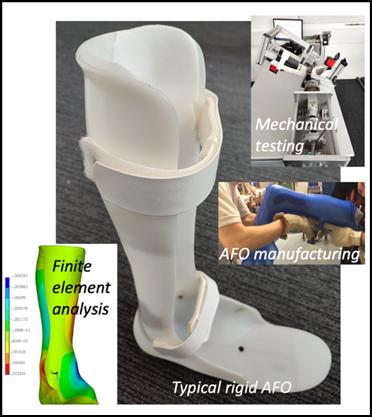
4 minute read
Using computer simulations to guide orthotic prescriptions
from HUB Magazine Issue 5
by IHMPublish
Trust : RWT
Author : Dr Nicky Eddison, Dr Panagiotis Chatzistergos, and Professor Nachiappan Chockalingam
The allied health professions in the United Kingdom are made up of 14 separate professions, of which prosthetics and orthotics are the smallest. Although small, orthotics has a beneficial impact on a range of clinical conditions and is vital to many clinical pathways. Many of which are policy priorities for the government and the National Health Service (NHS).



1.5% of the world’s population needs a prosthesis/orthosis and it was predicted in 2002 that the number of people requiring orthoses would increase by at least 31% (7,382,876 people) by the year 20203. The most recent estimate suggested that there are 2 million orthotic users in England alone. A significant number of people in the UK rely on orthotic prescriptions to carry out their activities of daily living, remain independent, reduce their pain, and reduce the risk of symptom deterioration. Rigid Ankle foot orthoses (AFOs) are orthotic devices which are designed to control, prevent, and enhance the movement of the lower limb. An estimated 90,000 AFOs are prescribed to patients each year in the NHS5. The rigidity of the AFO is essential to achieving the desired clinical outcomes. It should only deform a small amount from the chosen alignment if it is to achieve the clinical goals. A lack of rigidity can result in pain (for example in an osteoarthritic ankle where movement is not desirable), it can also reduce the stretching and strengthening of the lower limb musculature whilst walking, which has the potential to impact the patient’s quality of life and increase the need for surgical and medical interventions to lengthen muscles in the lower limbs for patients with neurological conditions.
Despite the ubiquity of these medical devices in healthcare, there is still a paucity of research on the most effective design to enable clinicians to achieve the desired clinical outcomes. Currently, there are no prescription guidelines which dictate how an AFO should be designed to ensure it is rigid enough to do the job it is designed to do. Prescription guidelines are still arbitrary and often based on experience or historical practice.
The lack of evidence-based guidelines for optimal AFO design results in poor treatment outcomes and poor patient experience7. It is also a cause of repeat prescriptions, which presents an additional cost to the NHS and delays patient treatment. This is often exacerbated by the long waiting lists in orthotic services nationally4. The ‘not right first-time’ issue of AFO fittings was a major cause of the NHS England national orthotic review which reported “The correct supply and fitting of orthoses can help improve quality of life by reducing pain, keeping people mobile and independent and preventing more invasive and expensive interventions like surgery, amputation, or the need for social care”2.



Without essential data on the impact of each element of the AFO design, in terms of stiffness, it is not possible to devise prescription guidelines and standardise treatment and reduce disparities in treatment outcomes.


Increasingly, computer simulations and artificial intelligence are taking a role in the clinical management of various conditions. Computer simulations can be used in the prescription of ankle-foot orthoses (AFOs) to help predict and optimise their performance for a particular patient. These simulations can be used to model a patient's gait and the mechanical properties of the AFO and can help orthotists and clinicians determine the best design and fit for the patient.
One approach to using computer simulations in AFO prescription is to use three-dimensional gait analysis, which involves recording a patient's gait using motion capture technology and then simulating the motion in a computer model. The simulated gait can be used to evaluate the biomechanical effects of different AFO designs and adjustments, such as changes in joint angles, muscle activation patterns, and ground reaction forces. Another approach is to use finite element analysis (FEA) to simulate the mechanical properties of AFOs and their effects on the patient's bones and muscles. This can be used to optimize the AFO design and materials, and to evaluate the potential risks of clinical complications.
Whilst all these are theoretically possible to develop patientspecific interventions, an essential first step to change the overall system is to understand these variables and make use of them in a structured way to aid the prescription process. Our research team used a novel approach by combining mechanical testing of a rigid AFO with computer modelling (finite element analysis) to demonstrate the efficacy of different prescription designs.

Based on this preliminary work, our research team has recently been awarded funding by Orthopaedic Research UK to continue this important research. Our work will impact all patients who are prescribed an AFO as part of their treatment. Patients will also benefit from a reduction of delays in treatment due to insufficient rigidity of the AFO structure at the fitting stage and improved clinical outcomes because of a more appropriate device. Clinicians will benefit from data-driven AFO prescription guidelines, turning a subjective process into an objective standardised process





South, Central and West (SCW) is home to our South of England Regional Hub.
South, Central and West (SCW) is an NHS organisation providing support and transformation services to health and care systems. Our purpose is to support you to achieve the best possible outcomes for people, communities and populations.



We are a non-profit-making part of the NHS, with shared values and goals for healthier, happier lives. Any small surplus we make is reinvested back into the NHS for the greater good.
Our 1,500 dedicated staff cover a wide area across the south of England but we also work nationally, acting as system partners, joining the dots between health and care through service transformation and essential system support. With deep roots in the health and social care system, we have a clear perspective on both current and future challenges, and a passion for supporting our customers to address them. March



